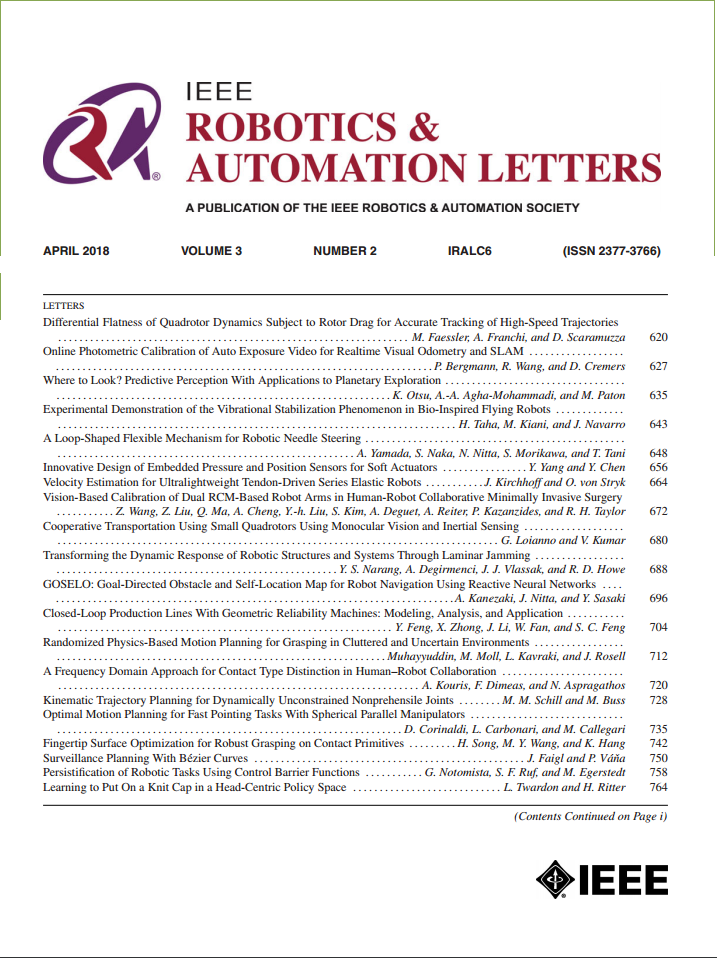Passive Multi-Task Compliance Control With Strict Priority Through Energy Tanks
IF 4.6
2区 计算机科学
Q2 ROBOTICS
引用次数: 0
Abstract
A robot with kinematical redundancy with respect to a main task may perform additional tasks simultaneously with the main one. Often, it is desirable to prioritize the performance of some tasks over that of others. To create a strict priority between the different tasks, meaning the performance of higher-prioritized tasks is unaffected by lower-prioritized tasks, null-space projections are often used. Null-space projections may, however, cause the closed-loop system to lose the desirable passivity property, which is necessary to ensure stable interactions with passive environments. In previous works, an energy tank has therefore been introduced to compensate for the potential activity stemming from the null-space projections. However, if the energy tank becomes empty when using these previous methods, the performance of the lower-prioritized tasks suffers more than when using a classical, non-passive hierarchical control scheme. Thus, a new approach to handling this case is proposed in this work. In the event of the energy tank becoming empty and unable to compensate for any null-space projection-induced activity, the hierarchy is ceded to preserve the passivity of the system, leading to better performance of the lower-prioritized tasks compared to previous passivation schemes. Output strict passivity of the closed-loop system is proven irrespective of the amount of energy available from the energy tank, and the performance of the proposed method is validated and compared to that of a classical hierarchical impedance controller and that of an earlier passivation method through simulation and experiments of redundant robotic manipulators.基于能量罐的严格优先级被动多任务遵从性控制
具有相对于主任务的运动冗余的机器人可以与主任务同时执行附加任务。通常,将某些任务的性能优先于其他任务的性能是可取的。为了在不同任务之间创建严格的优先级,意味着高优先级任务的性能不受低优先级任务的影响,通常使用零空间投影。然而,零空间投影可能导致闭环系统失去理想的无源性,这是确保与无源环境稳定相互作用所必需的。在以前的工作中,因此引入了一个能量罐来补偿由零空间投影产生的潜在活动。然而,如果使用这些方法时能量池变为空,则较低优先级任务的性能比使用经典的非被动分层控制方案时受到更大的影响。因此,本文提出了一种处理这种情况的新方法。在能量罐变空且无法补偿任何零空间投影引起的活动的情况下,放弃层次结构以保持系统的无源性,与以前的钝化方案相比,导致低优先级任务的性能更好。通过冗余机器人的仿真和实验,验证了所提方法的性能,并与经典的层次阻抗控制器和较早的钝化方法进行了比较。
本文章由计算机程序翻译,如有差异,请以英文原文为准。
求助全文
约1分钟内获得全文
求助全文
来源期刊

IEEE Robotics and Automation Letters
Computer Science-Computer Science Applications
CiteScore
9.60
自引率
15.40%
发文量
1428
期刊介绍:
The scope of this journal is to publish peer-reviewed articles that provide a timely and concise account of innovative research ideas and application results, reporting significant theoretical findings and application case studies in areas of robotics and automation.
 求助内容:
求助内容: 应助结果提醒方式:
应助结果提醒方式:


